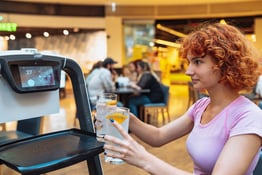When the pandemic forced Bartaco’s 25 dining rooms to close, the restaurant chain quickly dove into a major pivot. For the first time, it would start doing takeout.
“Before COVID, we just didn't believe our food carried – as we all know, individual tacos get soggy,” says Bartaco president Anthony Valletta. “But we found a way to revamp, get the quality up to our standards, and now [takeout and delivery] is about 17% of our total revenue.”
Currently, Bartaco sells to-go tacos as four- and eight-pack bundles only. The packaging is oven-proof. And everything’s separated, meaning the cold ingredients are placed in one package, the warm ingredients in another, and the tortillas get wrapped on their own.
“Our third-party mix is only about six or seven percent of the 17% [in revenue], so we’re doing a fair amount of in-store takeout, and that’s been found revenue for us,” says Valletta.
It’s not just takeout, however, that’s become a newfound success for Bartaco. Now that dining rooms have reopened, diners will find another major change – the company no longer employs servers to take customers’ orders.
Instead, Bartaco recently implemented QR code menu ordering, along with a brand new front-of-house role it’s titled “service leader”.
“It’s essentially a blend of a manager and a server,” says Valletta of the role. “And it’s been game-changing for us.”
When on the floor, a service leader’s primary job is to engage with guests and create a fun environment, says Valletta, who reports guest satisfaction ratings have increased steadily since the change. Employees across the restaurant are also earning more money, thanks to a new tip pooling structure put into place.
We sat down to chat with Valletta to learn more about Bartaco’s staffing model shift and how it’s paying off. Plus, he shares a few thoughts on the future of staffing in the fast casual sector.
Walk us through what went into the decision not to bring waitstaff back to their current roles and instead create this new service leader position.
COVID brought QR codes back. We partnered with a [QR code] company called OneDine, and we thought, “There has to be something here – how can we use this to allow the guests to control the pain points?”
Think about when you go out to eat and how many times you’re looking for your waiter to get a second cocktail or to get the receipt. Think about the time a typical server takes to leave a table, ring the order, and the errors that happen in between. We saw that we could [use the QR code] to take all of that away, and we wouldn’t need servers. But we thought, “How do we still create that [hospitality] experience?”
So we doubled down on our management team and created this job called “service leader”.
Can you tell me a little more about what that “service leader” role entails?
They each have zones – somewhere between eight to 15 tables, depending on the restaurant and the tenure of the employee. And they’ll help a guest in any way they like – make recommendations, clear tables, make paper airplanes with the kids.
Outside of the shift, service leaders have other areas of responsibility, whether that's ordering paper supplies or running schedules. It’s all the typical things a manager does in a traditional restaurant. We still have GMs and AGMs. And then the service leaders are our managers – we’ve just adjusted the title and the responsibilities during the shift.
We also do a lot in the communities, so service leaders will be out doing events, whether that's a toy drive or breakfast or an event at a local spin studio. In addition, we have a required coaching program where we work on the soft skills needed to develop leaders.
How many service leaders are typically employed at each location, and how does that number compare to the amount of servers that were previously employed?
It depends on volume. Our lowest indexing stores have a GM, an AGM, and three service leaders. Our busiest stores will have a GM, AGM, and up to 10 service leaders.
It’s probably more than 50% less than what we would’ve had for servers. So the service leaders are taking a larger section, but they’re not doing the nuances of what a server would’ve done.
Are you open to sharing what their pay structure looks like?
Service leaders are salaried and receive bonuses. Depending on the market, the base pay is anywhere from $55,000 up to $70,000, and bonuses can be anywhere from a couple thousand to $15,000, depending on the store’s performance.
We have a 401K with an employer match, health care, and life insurance. We also incentivize our team for guest feedback. We have a survey that goes out to all guests when they finish dining.. The guest surveys are attached to the zones of the service leaders. The top two ranked service leaders every week are given an additional bonus for that week.
You mentioned that service leaders go through a coaching program. Can you tell us more about what that looks like?
Everybody trains on hard skills at restaurants – how to write a schedule, visit a table, take reservations. If you want to become a GM, you have to know these tasks. But at the end of the day, that doesn't necessarily make a great GM. What makes a great GM or an executive chef is someone that's a great leader. They're inspiring. They're coaching and mentoring.
We work with a company called GiANT, and the system that we use creates what's called a voice order. There are five different voices. Staff take a survey at the beginning, and the coaching that they get is custom to their voice order. So you and I might be watching different seminars, but the message we get at the end is the same. It’s custom-coaching to the way they're wired.
There are different levels of mandatory participation that happens during paid working hours. Our tenured GMs and directors of operations spend four to six hours a month in the program. If you just joined, it’s about two hours a month. And then there’s a year-long, self-track that employees can also do. It’s not required, but some of our team have logged hundreds of hours on their own accord to continue their development.
Bartaco also moved to tip pooling – who partakes in the pool and what went into the decision to make that transition?
Service leaders don’t get tips. But as part of eliminating servers, now you have a blended team that’s taking care of guests, so we went to a fully pooled house, with a few exceptions based on laws in select locations.
Every [hourly worker] in the entire restaurant makes the exact same base wage, anywhere from minimum wage to above minimum wage, depending on the market. Then the tips are distributed evenly. At the end of the day, we all know that cooks have been underpaid in our industry for years. The dishwasher’s the hardest working person in the restaurant, and they’re always the least paid. So now, the people in the back, who have so much to do with creating our experience, are being compensated, and it’s equal pay for everyone, no matter who you are or how long you’ve worked for us.
It’s created this great team camaraderie, and the unintended benefit is our labor is starting to become self-governed. If I’m busting my butt next to Grace, and Grace isn’t pulling her weight, I’m not afraid to say something because if Grace is slower, my per-hour rate goes down.
Were there any challenges in that transition?
It’s hard to tell a typical line cook, “Hey, you’re going to make a $10-an-hour base, plus tips.” They think you’re nuts. So we had a little bit of turmoil in the beginning. But we’re a team-oriented restaurant, and now that we’re well into this, it’s been phenomenal. The average wage for our staff is $24 an hour, and in peak season, some stores are averaging $40 an hour.
We’ve also had phenomenal growth in our ability to attract talent. We’ve been north of 90% staffed since the middle of last year and holding strong. But more importantly, it’s been quality – we’ve been able to get really, really good people who are helping to improve our overall experience.
QR codes play a large role in Bartaco’s new staffing strategy. How have customers reacted to that shift and was there a visible learning curve?
Out of the gates, change is always challenging. When we first launched, we put out 10,000 guest surveys to understand their satisfaction with digital dining. We were really fortunate that we had 85% positive feedback. We had an additional 10% that was neutral feedback. And the remaining 5% was the detractors, but when we took some demographic data, about half of that 5% wasn’t our main demographic.
So we have about a 2.5% opportunity where we can approve, and we’ve brought in a digital experience manager and just hired a chief brand officer, and their main focus has been working with OneDine. We have calls weekly to find ways to enhance the UX-UI and reduce the friction with guests in the dining room.
Our target demo is also very youthful, so they’re organically comfortable on their phone, but we still offer a traditional menu if the guest’s not comfortable with technology. But we’ve had great adoption, and we continue to survey guests about the digital experience.
Do you think this kind of dining room model – QR code menus paired with service leaders or managers – is the future of fast casual?
Even before COVID, labor has always been a discussion, and it’s always going to be a challenge. The other real challenge has always been, when you incorporate technology, you typically have to sacrifice hospitality. But we’ve actually been able to increase the level of hospitality.
I truly think there will be a big wave in fast casual that’ll take on a similar approach and model. We’re getting phone calls almost every week about it, and we’re an open book. We’d love other restaurants to adopt this.
You’ve cut roughly half your employees but also increased the number of employees on salary. Are you breaking even financially with this model? Are you saving?
Our labor line has been really strong. In terms of an efficiency perspective, and in terms of a bottom line perspective, we're still doing really well. Even though we leaned into more fixed labor on salary, what we're able to do in our restaurants and out in the local community at events has offset the increase and has been able to help us keep a strong top line.
And salaried managers are just more invested for the long-term and in their growth. So we've seen gains both from the top and bottom line since switching over to this model.
Do you ever envision a similar staffing model seeping into dining sectors above the casual market?
Personally I don’t think so. I spent most of my career in fine dining, and there’s a finesse that technology can’t capture.
When you’re spending a significant amount of money at a fine dining restaurant, you expect an immense amount of personalized service. In fast casual, you’re not expecting the entire gamut of the dog and pony show. The price point fits, and the target demo for fast casual is much more youthful. Up-and-coming generations aren’t going to the steakhouse anymore. They’re looking for more value orientation, and I think that’s why it works so well for us. That generation is very tech savvy and actually almost prefer [to use technology] over the alternative.
But as fast casual and casual adopt more technology, I actually think you’ll see the service level in fine dining improve above what it already is. Really career-oriented servers aren’t going to be picked off by top-tier, casual concepts.





